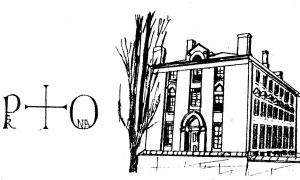Close to the London, Chatham, and Dover Railway, just beyond the Peckham Rye Station, is a very substantial building known as Nazareth House. It is situate in the Gordon Road, Peckham. It was formerly a convent, but when the railway destroyed the privacy of the grounds it was no longer adapted for its original purposes, and the nuns removed to a more suitable locality. Some half-a-dozen years ago it fell into the hands of the Camberwell guardians, and is now used by them as a supplementary establishment. (Mr. Castleman, the master, was appointed in 1867.) There are now within its walls 110 aged and infirm male paupers. The place is well adapted to the purpose, and the inmates, many of whom have been tradesmen in the pariah, are engaged, so far as their health permits, in various industrial pursuits. The grounds are about four acres in extent, and are kept in a high state of cultivation. The poor old men find work, involving no severe physical toil, but profitable in its results. Pigs and poultry, potatoes, parsnips, onions, carrots, rhubarb, lettuces, and other produce, make very respectable items in the “farm and garden” account This source of profit is steadily increasing. No doubt the old men do the work, and make and mend, so as to reduce the expenditure as far as possible; still it is gratifying to find that, five years ago, the farm and garden account showed a profit of £101; the next year it was £116, then £130, then £153, and last year – in spite of the loss of six tons of potatoes by disease, valued at £30 – the profit was £188.
The painting and graining are done by the inmates. In fact, a very substantial little pony-cart is amongst the more useful of their late productions. The Venetian blinds produced by some of them were very creditable specimens of their skill, and of course these and other articles produced effect a saving in the outlay which would otherwise have been incurred.
Nazareth House is the very picture of cleanliness, from the top floor to the basement. The common day room is light and warm, and in every respect comfortable. The sleeping apartments are lofty and well ventilated; and, in fact, everything appears to have been done that could reasonably be expected to make this retreat for the declining years of the aged and infirm poor as cheerful and as pleasant as it is possible for such a place to be, compatible with a due regard to the pockets of the ratepayers. All endeavour to make themselves useful: some act as blacksmiths, others do the washing, some the gardening, some are good carpenters, and others feed the pigs. In fact, pigs seem to be a leading feature. Over £80 worth of pork was produced last year, of which one-half was consumed in Nazareth House, and the other half in Camberwell Workhouse, and at the date of the last balance-sheet there was £80 worth of pigs in stock, and growing crops worth £60.
The sisters of the Christian retreat came to England in December 1848, and after residing at Peckham for about two years, removed to the Manor House, Kennington. They returned to Peckham in 1867, but were obliged to leave the latter residence on account of the railway.
Ye Parish of Camerwell W.H. Blanch (1875)
Eventually a larger building was needed, and in 1878 Gordon Road Workhouse was built in the grounds of Nazareth House.
Nazareth House destroyed by fire
On July 31st 1991 the Fire Brigade was called out again to Nazareth House in Gordon Road.

“Firefighters battled for more than two hours to bring the blaze under control at a derelict hostel. The roof and top floor of the four-storey building in Gordon road was destroyed in the blaze which began at around 12.20 p.m. on Wednesday among tyres at the building. Nobody was injured. The fire is being investigated by the Fire Investigation Unit.”
(South London Press, 2 August 1991)
Onlookers described the flames as “spectacular”. The following day demolition experts were called in to render the building safe, pulling down one of the last external features identifying the original role of the convent – the cross flanked by the alpha and omega symbols.
The house had been empty for four years and systematically vandalised. Fire Brigade and Police had been summoned several times and local residents anticipated this fate.
The site actually comprises two distinct plots of land: Nazareth House is number 22 and number 24 (Gordon Hall), the smaller house in front. In 1965/6 it was acquired by the GLC, and in 1972 transferred it to Lewisham Council. It was used as a hostel for homeless families until January 1979.
When sold by Lewisham in 1987 the building was still structurally sound. Planning permission was granted by Southwark for seven 2-bedroom houses on the site of Gordon Hall and the conversion of Nazareth House into 17 flats. In October 1988 it was said at auction to a development company. A few months ago it was to have been their next project after completion of one elsewhere in the country, and involve a 26 week programme of work.
The developers are now awaiting the decision whether the building can be salvaged economically.
Christine Bannan
Reprinted from Peckham Society News, Issue 45 (Autumn 1991)


